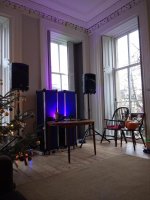I am building a system that includes 3" midbasses and ported 10" subs. I could either seal the midbasses and crossover at 200hz or port them and crossover at 100hz. Which would be better? By better I mean tighter, cleaner bass in the 100-200hz octave.
It seems to me that porting the midbasses and the subs both is overkill and introduces yet more phase and delay differences into the system, smearing the sound. But wouldn't the midbasses sound 'better' in the 100-200hz range than the subs?
It seems to me that porting the midbasses and the subs both is overkill and introduces yet more phase and delay differences into the system, smearing the sound. But wouldn't the midbasses sound 'better' in the 100-200hz range than the subs?
Sealed 3" and 200 Hz crossover. Any 10" sub will sing at 200 Hz.
At high power any 3" midbass will struggle at 100 Hz, sealed or vented.
At high power any 3" midbass will struggle at 100 Hz, sealed or vented.
What crossover slope are you considering? Whenever I go higher than 80Hz, I prefer LR8 (48dB/oct) slopes to reduce localization.
What crossover slope are you considering? Whenever I go higher than 80Hz, I prefer LR8 (48dB/oct) slopes to reduce localization.
He said "subs".
I assume he meant one for each channel.
Tre'
If your playing at high output levels I would consider a higher crossover point.
I used 120Hz LR4 the other day with the attached configuration bass was not locatable and no noticeable distortion until hitting the limiters where the bass just got a less loud. Using the same tops without subs they start heavily distorting at the same levels. I would recommend using an active crossover which will be adjustable as you will need to equalise the bass anyway. This system was just using a cheap analogue active two way crossover which has a setting for 75Hz and 120Hz.
2*1.4" compression drivers, 2*12" midbass, 6*15" sub bass
I used 120Hz LR4 the other day with the attached configuration bass was not locatable and no noticeable distortion until hitting the limiters where the bass just got a less loud. Using the same tops without subs they start heavily distorting at the same levels. I would recommend using an active crossover which will be adjustable as you will need to equalise the bass anyway. This system was just using a cheap analogue active two way crossover which has a setting for 75Hz and 120Hz.
2*1.4" compression drivers, 2*12" midbass, 6*15" sub bass
Attachments
There are many factors that go into this decision. At least, you need to outline the geometry of your system in the room. And much else.
One common misconception is taking lab tests that should localization down to 80 Hz and relate that to stereo music. Just fine to have a mixed-bass sub crossed over as high as 140 Hz with no degradation of stereo (or higher if hidden near your main speakers) provided the speakers are pretty clean and the Xover slopes are steep.
B.
One common misconception is taking lab tests that should localization down to 80 Hz and relate that to stereo music. Just fine to have a mixed-bass sub crossed over as high as 140 Hz with no degradation of stereo (or higher if hidden near your main speakers) provided the speakers are pretty clean and the Xover slopes are steep.
B.
One common misconception is taking lab tests that should localization down to 80 Hz and relate that to stereo music.
That's based on the use of 12 db/octave slopes and achieving a certain level of attenuation at 200 Hz, below which we find it more difficult to identify where sound is originating from.
Use higher slopes, and you can move the cutoff frequency higher. Of course, if the subwoofer is located right next to the main speakers (e.g. a 2.1 way "boom box" build), then you can use a considerably higher cutoff frequency.
- Status
- Not open for further replies.
- Home
- Loudspeakers
- Subwoofers
- Subwoofer Crossover Frequency
